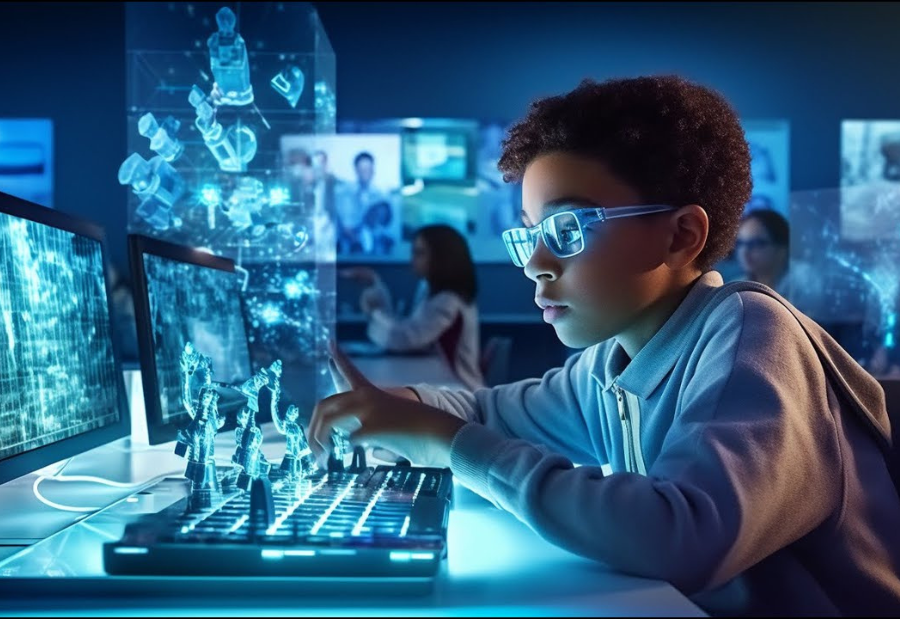Artificial Intelligence has emerged to be a popular and vital tool in every sector of the society and it has certainly impacted the education sector too. This constant evolution of technology promises us a future era of efficiency, learning, and creativity.
According to research from Britannica Education, the first AI program was created in 1951. In the 1950s, British mathematician and computer pioneer Alan Turing asked whether machines could think, sparking the development of AI concepts we still use today. As technology advanced over the decades, it eventually found its way into classrooms around the world.
Today, AI is transforming education, especially in K-12 settings, by enhancing data analysis and helping to improve teaching and learning. With the growing use of AI-powered tools, the potential for better, more personalized learning experiences is immense. As AI continues to evolve, it will keep unlocking new opportunities for both students and educators, shaping the future of education in exciting ways.
This blog post will reveal the transformative power of AI in education, as AI educators are now looking to integrate more and more AI tools into their academic courses.
Artificial Intelligence – Importance for Students!
AI is transforming how students learn and how teachers teach, creating exciting opportunities for personalized education, smoother school management, and better results for students. The adoption of AI has immense benefits for students in terms of their academic performance, personal growth, and overall learning experience.
And here’s why:
Instant Feedbacks
One of the major drawbacks of traditional education is the delayed feedback students receive on assignments and examinations. AI-powered platforms provide instant feedback, allowing students to immediately understand their mistakes and work on them. This continuous feedback loop helps students learn from their mistakes and improve over time.
Moreover, AI allows for real-time monitoring of progress, enabling students to track their development and adjust their study habits accordingly. This helps students stay motivated, as they can easily see their improvements over time.
Increased Interactions
AI is making learning more interactive and engaging for students. Through gamification, simulations, and virtual assistants, AI creates a more immersive learning environment. This increased engagement encourages active participation, helping students retain information more effectively.
AI-powered learning platforms are designed to keep students engaged by incorporating multimedia content, such as videos, infographics, and interactive lessons, into their curriculum.
Personalized Learning Paths
AI-powered systems are designed to cater to the individual needs of students. Each learner has a unique learning style, and AI can adapt lessons to better suit them. With AI, students gain access to customized content, matching their skill level and learning pace, improving their understanding of the subject matter. By using AI, students can focus on areas where they need the most improvement, ensuring that their strengths are further enhanced while also addressing their weaknesses.
Education Available to All
AI opens up opportunities for students with disabilities by providing assistive technologies that make learning more accessible. For instance, AI-powered voice recognition and text-to-speech tools can help students with visual impairments or dyslexia. Language barriers can also be overcome through real-time language translation and transcription services, allowing students from different linguistic backgrounds to access the same educational resources.
Artificial Intelligence – Importance for Educators!
Here’s how AI has a transformative effect on teachers:
Refined Teacher-Student Interaction
AI-powered platforms enhance communication between teachers and students, especially in remote learning environments. With AI-driven chatbots, teachers can provide instant support to students, answering questions, clarifying doubts, and providing guidance in real time. This improves the teacher-student relationship and helps students feel more supported.
Reduced Workload
AI reduces the workload of teachers by automating repetitive tasks such as grading, scheduling, and report generation. This allows teachers to focus more on lesson planning, student engagement, and other essential teaching tasks. The time saved can be redirected towards personalizing education for students and engaging in meaningful one-on-one interactions.
Data-Driven Insights
AI gives teachers access to valuable data insights that help them understand student performance better. Teachers can track student progress, identify trends, and adjust their teaching methods accordingly. By using data-driven insights, educators can tailor their lessons to address individual needs, ensuring that no student falls behind.
AI Integration in the Indian Education System
Incorporating AI into India’s education system can greatly improve both the quality and accessibility of education, and the Union Budget’s investment in this area will help make this vision a reality.
Here are some of the key highlights as to why India should integrate AI in its education sector:
Cost-Effective Education: AI can reduce the cost of education by making learning materials and resources more widely available at a lower cost.
Interactive Learning: AI can make education more engaging through tools like virtual classrooms, interactive simulations, and games that help students learn in fun and innovative ways.
Improved Access to Education: AI can help bridge the education gap, especially in rural and remote areas, by providing online resources, virtual tutors, and AI-driven platforms.
Budget Allocation for AI: The Indian Union Budget has allocated funds to promote AI in education, recognizing its potential to transform learning. This will help in developing smart classrooms, AI-based tools, and research initiatives.
Personalized Learning: AI can help create personalized learning experiences for students. It can identify their strengths and weaknesses, allowing teachers to tailor lessons to each student’s needs.
Supporting Skill Development: AI can play a key role in skill development programs by offering customized training in various fields, making students ready for the future job market.
Data-Driven Insights: AI can analyse large amounts of data to improve education strategies, identify trends, and make decisions that benefit students and teachers.
In Conclusion
AI in the education sector is making learning more personalized, efficient, and engaging for both students and educators. The integration of AI technologies enhances the learning experience and also streamlines administrative functions, creating a more efficient and forward-thinking educational ecosystem.
As AI continues to evolve its role in education, AI-driven tools and platforms, educational institutions can foster an environment of continuous improvement, preparing students for a technology-driven future and ensuring that teachers are equipped to meet the needs of every learner.
Also read: Viksit Workforce for a Viksit Bharat
Do Follow: The Mainstream formerly known as CIO News LinkedIn Account | The Mainstream formerly known as CIO News Facebook | The Mainstream formerly known as CIO News Youtube | The Mainstream formerly known as CIO News Twitter
About us:
The Mainstream formerly known as CIO News is a premier platform dedicated to delivering latest news, updates, and insights from the tech industry. With its strong foundation of intellectual property and thought leadership, the platform is well-positioned to stay ahead of the curve and lead conversations about how technology shapes our world. From its early days as CIO News to its rebranding as The Mainstream on November 28, 2024, it has been expanding its global reach, targeting key markets in the Middle East & Africa, ASEAN, the USA, and the UK. The Mainstream is a vision to put technology at the center of every conversation, inspiring professionals and organizations to embrace the future of tech.




